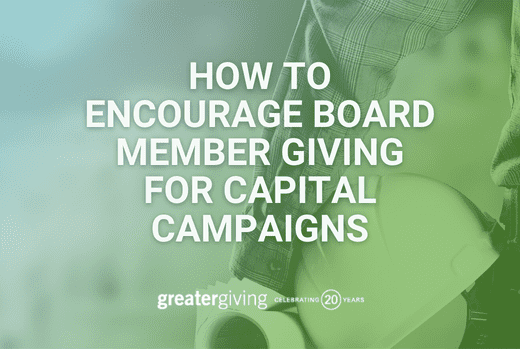
In capital campaigns, board giving matters. We’ve seen that contributions from board members often account for 20% or more of a campaign’s total donations. The amount will of course be different for every organization, but it’s still a standard expectation for board members to be engaged and push the campaign forward in whatever ways they’re able, including making a gift.
However, asking a board member for a personally meaningful gift can be awkward. So, board giving is all too easily put to the side without a concrete plan in place. If you make board giving a part of your capital campaign planning from the start, you’ll help ensure your campaign gets off to a powerful start.
How nonprofits approach board giving
Nonprofits take a variety of approaches to board member contributions during capital campaigns. These can include:
- “Give-get” policies in which board members are asked to be responsible for sourcing a specific amount of money from themselves, other donors, and/or sponsors.
- Asking board members to give a gift that is personally significant to them.
- Asking board members for gifts but not specifying any practice for determining the amount.
- Discussing board contributions during one-on-one meetings with each board member.
- Providing pledge forms and gently encouraging they be returned by a particular date.
These options are likely to yield different results. The more vague and hands-off, the less the board is likely to give. Providing structure and encouragement improves the results. It’s most effective to have a clear and specific plan for soliciting board members in place early in the campaign. We recommend nonprofits follow a clear process that involves setting specific giving goals, soliciting every board member individually, and reporting the results.
Our Recommended Approach: 6 Steps
This is how we recommend nonprofits handle board giving for their capital campaigns:
1. Form a committee of board members.
2. Determine individual giving targets and a total goal.
3. Discuss board giving plans as a group.
4. Solicit each board member.
5. Report on your progress.
6. Celebrate reaching your goal.
First, avoid the potential awkwardness of having staff solicit board members by instead forming an ad hoc committee of board members to work on the board campaign. Your executive or
development director will organize and manage the process. This group will develop and implement a strategy and meet several times over one or two months in the early phases of the campaign.
In this group’s first meeting, you’ll need to determine a collective board giving goal and individual giving targets. A specific dollar goal makes it easier for board members to make informed decisions when making their contributions. Consider each member’s giving patterns and basic prospect research to determine potential ranges for their individual gifts. Add these up to generate your collective goal.
Then, meet with the entire board to present your collective giving range and discuss other details of the board giving initiative, including its target rate of participation (ideally 100%), what the solicitation process will entail, and a timetable for when all gifts should be committed. After this discussion, the solicitation process begins over the coming days and weeks, depending on your timeline.
A board member from the committee should meet with each board member individually to discuss specific amounts and ask for the gift.
Though board members should already be intimately familiar with your campaign’s rationale and case for support, you should still lay out exactly how the campaign’s success will positively impact your mission, just as you would when soliciting an outside prospect.
As contributions and pledges are made, track your progress and provide gentle nudges when needed to stick to your timetable. Provide updates to the entire board. Once you’ve reached your goal, it’s time to celebrate! Whether you go for something casual or more official, it’s important to recognize not just the impactful contributions of your board members but also the hard work of the ad hoc committee that handled this campaign-within-a-campaign.
Why This Approach Works
This six-step process effectively turns board giving into a team effort handled by the board members themselves. Feeling that it’s been a true team effort makes reaching the goal even more meaningful.
Board members should understand the massive impact that their support has on moving the campaign forward. Following the process outlined above and reaching 100% participation can make a huge difference—in terms of hard numbers but also the feelings of commitment, excitement, and momentum that it generates throughout your entire organization.
If you’re on the board of an organization that’s considering a capital campaign, there are things you need to know. This guide will help you understand your own role, and that of the entire board, during a campaign. Download this free guide today!
Amy Eisenstein, ACFRE, and Andrea Kihlstedt are co-founders of the Capital Campaign Toolkit, a virtual support system for nonprofit leaders running successful campaigns. The Toolkit provides all the tools, templates, and guidance you need — without breaking the bank.

Great content, indeed! Thank you for sharing informative content. I will definitely try your advice. Great work!
It is nice to read this! So much information!